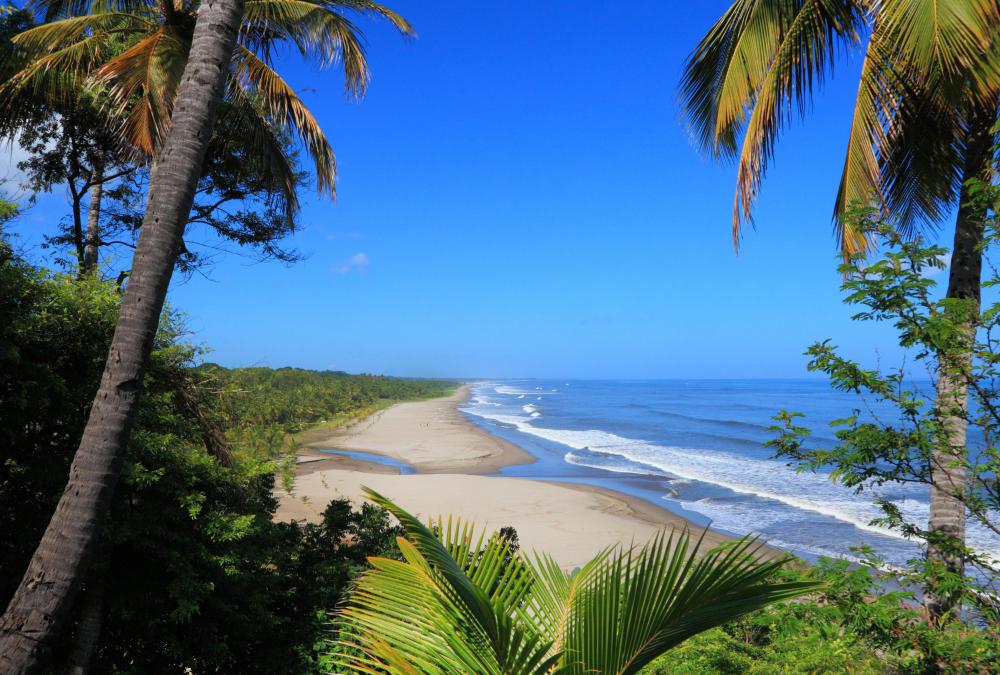At AllThingsNature, we're committed to delivering accurate, trustworthy information. Our expert-authored content is rigorously fact-checked and sourced from credible authorities. Discover how we uphold the highest standards in providing you with reliable knowledge.
What is an Atoll?
An atoll is an island that is constructed of coral and encircles a lagoon. Found most often in tropical sections of the Pacific and Indian oceans, atolls are noted for creating an attractive and peaceful setting.
During the middle of the 19th century, Charles Darwin developed was the developer of the more commonly accepted theory of how an atoll is formed. He understood the creation process as having its roots in volcanic activity. The basis for his theory came from personal observations that Darwin made during a six-year voyage around the southern section of the Pacific Ocean.

According to Darwin, the atoll was the result of the gradual sinking of a volcanic island that has long since cooled, leaving behind an open crater in the middle section of the island. As the island begins to sink, the surrounding territory of the island falls beneath the surface of the water. At the same time, the coral reef that is found around the fringes of the island remains and gradually is built up through the natural practice of the accumulation of marine organisms that become part of the reef. This creates a barrier reef around the remaining section of the island, forming the perfect conditions for the development of a lagoon. Once the lagoon is formed and is more or less encircled by the barrier reef, an atoll is the final product of this gradual metamorphosis.

Most of the examples of these structures are found in warm waters. The reason for this is that the tropical climate is necessary to help build up the barrier reefs and create the lagoons that connect the islands and the reef formations. When conditions of weather and reef formation are understood to be minimally suitable for the formation of an atoll, they are said to be at the Darwin Point.

Many of the world’s most popular atolls are found in the Pacific Ocean, especially around the Caroline and Marshall Islands. The Indian Ocean is also home to many, such as the Atolls of the Maldives. Very few atolls are found in the Atlantic Ocean, although there is a series of eight found just off the eastern coast of Nicaragua.
Frequently Asked Questions
What exactly is an atoll?

An atoll is a ring-shaped coral reef, island, or series of islets that encircle a lagoon, either partially or completely. They are usually found in warm ocean waters and are formed from the growth of coral reefs around a volcanic island that has since subsided below sea level, leaving the ring of coral exposed.
How are atolls formed?
Atolls are formed through a process that begins with a volcanic island which becomes surrounded by a coral reef. Over time, the island erodes and sinks due to subsidence and sea level changes, while the coral continues to grow upwards. Eventually, the original island disappears beneath the water, leaving a lagoon surrounded by the coral reef.
Where are atolls commonly found?
Atolls are commonly found in the warm, tropical waters of the Pacific and Indian Oceans. The Maldives, for example, is a nation composed entirely of atolls and is the lowest-lying country on Earth. The largest atoll in the world by land area is Kiritimati (Christmas Island) in the Pacific Ocean.
What kind of biodiversity can be found in atolls?
Atolls boast a rich biodiversity, including various species of coral, fish, mollusks, birds, and marine mammals. They serve as important habitats for marine life, offering food and shelter. The coral reefs are particularly crucial as they host an estimated 25% of all marine species, despite covering less than 1% of the ocean floor.
Are atolls at risk due to climate change?
Yes, atolls are at significant risk due to climate change. Rising sea levels can lead to increased flooding and erosion, while warmer ocean temperatures can cause coral bleaching, which damages the reef ecosystem. Atolls' low elevation makes them particularly vulnerable to the effects of climate change.
Can people live on atolls, and how do they sustain their communities?
People do live on atolls, and they often sustain their communities through fishing, tourism, and the cultivation of crops like coconuts. However, living on atolls can be challenging due to limited freshwater resources, vulnerability to storms, and the impacts of climate change, which threaten their livelihoods and homes.
AS FEATURED ON:
AS FEATURED ON:














Discussion Comments
I had the pleasure of visiting Millennium Atoll, which used to be called Caroline Atoll. It got renamed because it was the first geographic area in the world to see the light of the new millennium.
This atoll is very narrow and long. While I was there, I got to see the huge arthropod that the island is famous for, the coconut crab. It's the biggest arthropod in the world, and some of them can weight about nine pounds.
Like many other atolls, this one is in danger of someday being totally inundated with sea water. If the polar ice caps continue to melt and the sea level consequently continues to rise, then we could lose many beautiful atolls.
My sister spent her honeymoon on an atoll island. She later showed me a map of the place, and the resort was on a narrow strip of land. The majority of the atoll was made up of water.
Because of this, she did some awesome snorkeling. Her husband even went scuba diving, but she didn't have the courage for that. They had an underwater camera with them, and they took some priceless photos of strange fish and other sea creatures.
She loves the ocean so much, and being surrounded by all that salt water overwhelmed her with happiness. I think that visiting an atoll was even better for her than just a regular coastal vacation, because there was marine life and sea water everywhere she turned.
@StarJo – I'm sure it is beautiful, but remember, with paradise, there comes a price. The Maldives are in a dangerous spot, and the area was devastated after the tsunami of December 2004.
Many people died, and many others lost their homes. They had enjoyed years of beautiful surroundings, but in a moment, their world turned upside-down.
Because they are located in the Indian Ocean, the Atolls of the Maldives are always in danger of being hit by a big tsunami. Keep this in mind before you decide to travel there. It's enough to keep me far away.
It is my dream to one day visit the Atolls of the Maldives. This area is frequently featured in island paradise calendars, and I don't see how any place could be more beautiful.
The water is like blue crystal, and it appears calm in the photos. The palm trees reach out at curved angles, and some even have hammocks strung between them.
These atoll calendar photos are the perfect advertisement for the Maldives. I bet that many a tourist has decided to vacation there because of a picture they saw on the front of a calendar in a store.
Post your comments